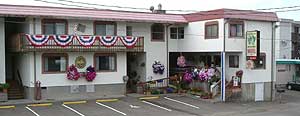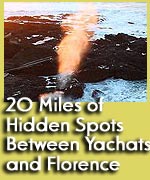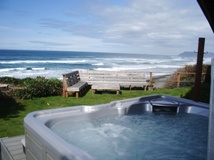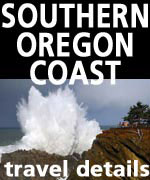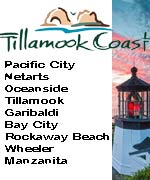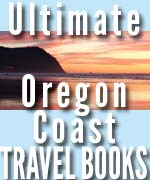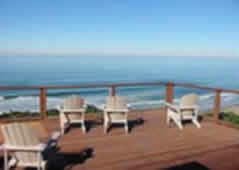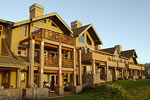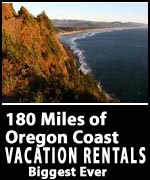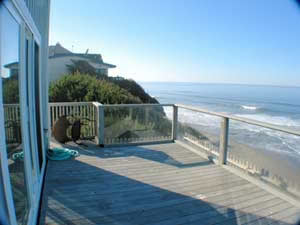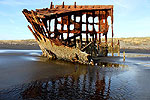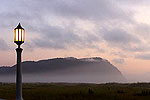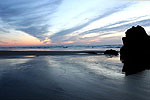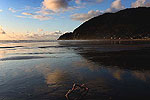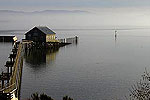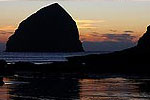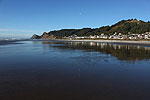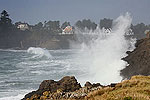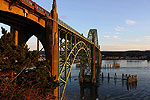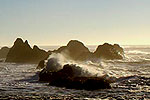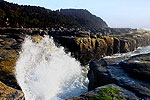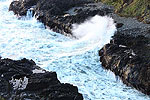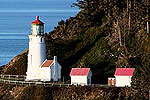 |
Wacky Weather on Oregon Coast Recently, More Coming |
|---|
Covering 180 miles of Oregon coast travel: Astoria, Seaside, Cannon Beach, Manzanita, Nehalem, Wheeler, Rockaway, Garibaldi, Tillamook, Oceanside, Pacific City, Lincoln City, Depoe Bay, Newport, Waldport, Yachats & Florence.
03/25/08
Secrets of the Season |
Week of Wacky Weather and Waves on Oregon Coast
 |
| Wild waves in Yachats on Saturday |
(Oregon Coast) – As snow looms on the horizon for much of Oregon, the Oregon coast gets prepared for a trace of that as well as looks back at a run of interesting, wacky weather.
From Wednesday through Saturday, enormous waves were typical along the central coast, no matter what the conditions. In fact, rather paradoxically, there were little or no clouds and often a lack of wind, yet gigantic surf was the norm along much of the coastline.
To top it off, Thursday and Friday of last week saw an interesting mix of sun, rain, hail and even a slight dusting of snow, although it was primarily sunny.
For complete, up-to-date, Oregon Coast Weather, click here.
|
Tradewinds Motel, Rockaway Beach. All rooms are immaculate and have TV’s, VCR’s and in-room phones w/ data ports. Oceanfronts have queen bed, a double hide-a-bed, kitchen, cozy firelog fireplace and private deck. Both types sleep up to four people. Others are appointed for a two-person romantic getaway, yet still perfect for those on a budget. Elaborate oceanfront Jacuzzi suite has two bedrooms, kitchen, double hide-a-bed, fireplace and private deck, sleeping as many as six. For family reunions or large gatherings such as weddings, some rooms can connect to create two-room and three-room suites. Some rooms pet friendly. 523 N. Pacific St., Rockaway Beach. (503) 355-2112 - 1-800-824-0938. www.tradewinds-motel.com |
“It only lasted a couple of minutes,” said Keith Chandler, manager of Seaside Aquarium. “It melted pretty much right away.”
Snow was also reported in Depoe Bay. BeachConnection.net staff spotted a small dusting in Lincoln City on Friday.
 |
| Huge breakers came barrelling in at sunset at Lincoln City on Friday: the weather had turned more plesant by that time. |
Saturday was gorgeous, and then Sunday was a slog of heavy rain, fog and even gusts as high 45 mph on the headlands.
Monday and Tuesday have turned out beautifully sunny as well, with highs around 50 and little or no wind.
“It was nasty here,” Chandler said of Sunday.
“It was raining diagonally,” said Guy DiTorrice on Monday, a beach expert and Newport resident. “It sometimes came up and got under my rain gear. Today it’s really mellow – maybe three-foot, four-foot waves.”
Meanwhile, monstrous tidal conditions created quite the spectacle for most of last week, especially on the central coast, in spite of the periods of sun and blue sky. Friday night, in Depoe Bay, the sky was clear and a full moon lit up gargantuan breakers slamming into the headlands there.
 |
| Big waves at Depoe Bay |
Saturday, the waves had calmed a little. But BeachConnection.net caught some dramatic action in Yachats. One onlooker from Eugene said he’d been up on Cape Perpetua earlier in the day, and had managed to see some whales in spite of the big breakers close to shore.
“I saw a couple whales spouting,” he said. “ ‘Was really cool.”
What’s unusual about these waves is that normally this means a storm is heading this direction. Often, it takes a day or so for such large surf to reach the coast, after its kicked up by heavy winds out to sea.
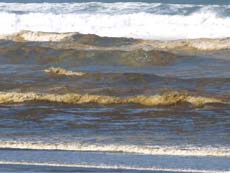 |
| Brown waves in the Seaside area |
But Wednesday, Thursday, Friday and Saturday saw mostly nice, calm conditions – except for the first half of Friday, which was rainy, wet and extremely cold.
“Sometimes the storms don’t come in, but you can still have big surf,” said Chandler. “You can have not bad weather on the beaches, but somewhere out there, there’s a storm that’s swinging by, missing us. And those winds are kicking up our surf. You can have them far out there, like Hawaii or Alaska, and the storm will just pass on by. Normally, they do come here. Sometimes they don’t. And those winds will kick up the surf there, and those waves will reach us a day later.”
|
Arch
Cape Property Services.
Dozens of homes in that dreamy,
rugged stretch between Cannon Beach and Manzanita known as Arch
Cape. Oceanfront and ocean view , or just a short walk from the
sea. |
The other things that often typified last week’s wacky weather were schizophrenic quick changes in weather. Heavy squalls would be pounding the coast with rain one minute – five minutes later the sun could be breaking out.
 |
| Large surf action in Yachats on Saturday |
Chandler said this is the norm for coastal weather in the spring.
By Saturday at dusk, the cold kicked in, and temperatures were closing in on the 30’s.
Monday morning was the third day in a row of extremely cold temps, Chandler said. “Today was the worst. I spent five minutes scraping the ice off my windshield.”
Spring also means a lot of diatoms blooming in the ocean– the form of phytoplankton off which much of the ocean feeds. These are microscopic organisms whose tiny skeletons create the bulk of what is seen as sea foam.
Exceptionally large blooms of diatoms can create big brown patches on the sea, brown wave, or even large clumps of dark brown goo on the beaches. It’s doing that now on the north coast and the central coast, although much heavier in the Seaside area, where it’s been a regular occurrence most of the winter.
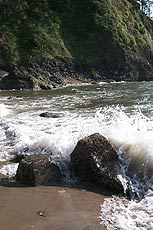 |
| Sun and big surf at Cape Lookout State Park |
It’s causing really dark patches along with very dark, brown chunks of foam in Seaside – so much that the Seaside Aquarium and other businesses have been putting up posters telling visitors that it’s not pollution or oil from a shipwreck offshore.
Some brown spots have been seen on other parts of the coast, but not nearly as pronounced as in Seaside or Cannon Beach.
This foam can be quite spectacular when spring storms hit. Sometimes it’s so thick it looks like flurries of snow drifting across the highway or beaches.
“It’s a good thing,” said Chandler. “It’s a healthy thing. It’s just a lot of diatoms. It’s been a good year for diatoms.”
Other wild sights are sometimes on tap because of another form of phytoplankton called dinoflagellates. These little creatures glow in the water at night, and on the beaches for a few hours after washing up on shore. It’s nicknamed “glowing sands” because they emit a faint, bluish, green glow when stepped on or disturbed. This is only visible in very dark conditions at night.
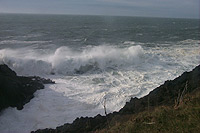 More
wacky weather is coming to the coast and the coast range, which is not
welcome news to tourism businesses that are wary of more snowy conditions
on the passes which may hinder visitor traffic. Snow levels are expected
to drop to around 1000 feet over the next few days, which likely means
at least some dusting on the upper elevations of the coast range.
More
wacky weather is coming to the coast and the coast range, which is not
welcome news to tourism businesses that are wary of more snowy conditions
on the passes which may hinder visitor traffic. Snow levels are expected
to drop to around 1000 feet over the next few days, which likely means
at least some dusting on the upper elevations of the coast range.
Weather forecasters are quick to point out that most of the snow will not stick to the roads, and that which does will likely be melted during the daylight hours. Many spots in the coast range will experience a mix of snow and rain, which won’t affect traffic flow.
The roads to the coast are not expected to be icy.
For complete, up-to-date, Oregon Coast Weather, click here.
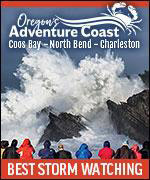 |
A1 Beach Rentals, Lincoln City. Perfect for large family vacations all the way down to a getaway lodging for two - with over 25 vacation rental homes to choose from. A breathtaking collection of craftsman or traditional beachfront homes, or oceanview houses – from one to seven bedrooms. In various areas of Lincoln City and overlooking the beach, with some in Depoe Bay. All kinds of amenities are available, like hot tubs, decks, BBQ, rock fireplaces, beamed ceilings and more. Some are new, some are historic charmers. Lincoln City, Oregon. 1-(503)-232-5984. www.a1beachrentals.com. |
 Inn
at Cannon Beach. Beautifully wooded natural setting at quiet south
end of Cannon Beach. Great during winter storms with a new book by
the fireplace – or when the sun is out for family fun and beach
strolling. Handsome beach cottage-style architecture. Lush flowering
gardens and naturalized courtyard pond. Warm, inviting guest rooms.
Continental buffet breakfast. Warm Cookies. Family and Pet Friendly.
Welcome gifts. Smoke-free. Complimentary Wireless Connectivity. Wine
and book signing events. 800-321-6304 or 503-436-9085. Hemlock At
Surfcrest, Cannon Beach, Oregon. www.atcannonbeach.com. Inn
at Cannon Beach. Beautifully wooded natural setting at quiet south
end of Cannon Beach. Great during winter storms with a new book by
the fireplace – or when the sun is out for family fun and beach
strolling. Handsome beach cottage-style architecture. Lush flowering
gardens and naturalized courtyard pond. Warm, inviting guest rooms.
Continental buffet breakfast. Warm Cookies. Family and Pet Friendly.
Welcome gifts. Smoke-free. Complimentary Wireless Connectivity. Wine
and book signing events. 800-321-6304 or 503-436-9085. Hemlock At
Surfcrest, Cannon Beach, Oregon. www.atcannonbeach.com. |
 |
|
The Ocean Lodge. There will not be another property built like this in Cannon Beach in our lifetimes. Rare, premiere ocean front location; handsome, dramatic architecture and tasteful, fun (nostalgic) beach interiors. Overlooks Haystack Rock. 100 percent smoke free. Imaginative special occasion packages. Massive wood burning lobby fireplace. Library w/ fireplace, stocked with impressive book collection. Pet and family friendly. Lavish continental buffet breakfast. In-room fireplaces, mini-kitchens. Jacuzzi tubs in select rooms. DVD players, complimentary movies. Morning paper. Warm cookies. 888-777-4047. 503-436-2241. 2864 Pacific Street. Cannon Beach, Oregon. www.theoceanlodge.com |
 |
Lincoln City Vacation Homes Something for everyone: smaller homes with a view to a large house that sleeps 15. All are either oceanfront or just a few steps away – all with a low bank access and fantastic views. Most are in the Nelscott area; one is close to the casino. You’ll find a variety of goodies: fireplaces, multiple bedrooms, dishwashers, Jacuzzis, washer/dryers, hot tubs, cable TV, VCR, barbecues; there’s a loft in one, and another sprawling home has two apartments. Pets allowed in some homes – ask first. Each comes with complete kitchens. Most have seventh night free. Prices range from winter $85 to summer $230 per night. www.getaway2thecoast.com. 541-994-8778. |
RELATED STORIES
Click here for video of Dec. storm aftermath
Oregon Coast Best of Awards for the Year And the winners are: best of Oregon coast restaurants, lodgings, science, odd events in nature and stunning moments for 2007
Watching Transformations of Oregon Coast Beaches Seasons change and so do beaches, revealing different sides and a variety of eye-popping sights
Staggeringly Cool Ideas for Oregon Coast Romance Be it the season of Valentine's or be it any time of the year, Oregon's coastline has essentially cornered the market for cuddle-inducing possibilities and gushy activities for the hand-holding set
Day or Night Mysteries and Merriment on Oregon Coast It's more than just nightlife that comes to life, but the beaches offer major opportunities
Oregon Coast Travel Site Goes Wireless Provides Lodging Reports - Oregon Coast Beach Connection now has mobile lodging and dining listings, along with weekly lodging availability reports


